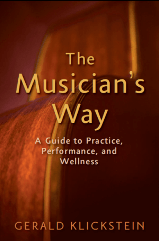
–The Musician’s Way, p. 211
We musicians have it in our power to attract hordes of enthusiastic fans.
And one of the most effective ways we can do so is to offer innovative concert programs that make listeners hungry to hear us.
Even so, I’ve found that many classical and jazz artists perform comparable standard repertoire to a degree that they verge on being interchangeable.
Sure, star musicians can present unimaginative programs and fill auditoriums. Rising performers, though, are unlikely to succeed by following that same worn path.
“Many classical and jazz artists perform comparable standard repertoire to a degree that they verge on being interchangeable.”
Here then are three traits of concert programs that command attention from listeners and presenters: relevance, empathy, and exclusivity.
Three Traits of Successful Concert Programs
1. Relevance
How would target audiences connect culturally and intellectually with the program content?
Classical and jazz audiences have been shrinking for years, so it won’t suffice to just compile programs of standards and then announce the composition titles. That strategy just reaches the same small club of established listeners.
To draw in new audiences, we have to make connections between the music we love and the things people care about. My article “Let’s Get Relevant” explores ways in which we can forge those sorts of connections, one way being to assemble programs based on relevant concepts and then coin appealing titles.
Bear in mind that our artistic integrity is our most valuable asset, so we shouldn’t dumb down but rather provide meaningful inroads to great music.
As an illustration, check out this charming program by Taiwanese classical pianist Shao-Hsun Chang – a 50-minute concert titled “Feathered Friends: Great Composers Celebrate Birdsong.” The recital brings together music by composers ranging from Rameau to Beethoven to Liszt to Messiaen and is ideal for a weekend afternoon. Well marketed, it can draw in people who share the pianist’s love of nature regardless of whether they would ordinarily attend a classical concert.
“Our artistic integrity is our most valuable asset, so we shouldn’t dumb down but rather provide meaningful inroads to great music.”
Here’s another application of the relevance concept: The Dortmund Konzerthaus orchestra brought legions of new listeners to their concerts during the 2010-2011 season by creating relevant connections between their repertoire and their community, which embodies proud agricultural traditions.
Note that, as shown in this video, the orchestra communicated their identity as an institution that performs great classical music, and they helped people feel a relationship to that music. Of course, to retain and grow their audiences, additional programming innovations were essential, which they have successfully done.
2. Empathy
How would target audiences connect emotionally with the program content?
Relevance is crucial, but it might not be enough to get people to venture out to concerts, especially to ones by performers they don’t know.
If we can also trigger empathy, people will feel a deeper attraction to our art and the aesthetic experiences we provide. For sample programs and projects rich in both relevance and empathy, see those created by the Del Sol String Quartet.
Communication is central to spawning empathy, and the following video dramatizes how well-chosen words can generate both empathy and involvement.
Musicians and concert presenters can employ parallel communication strategies in their concert titles, social media, press releases, and more.
3. Exclusivity
In what ways do the program and presentation provide experiences not readily available elsewhere?
Our programs also need to provide alluring experiences that people can’t have unless they attend our shows. Such differentiation is central to any entrepreneurial venture.
In contrast, conventional programs – say, classical piano recitals of music solely by Schumann or Chopin – can leave music lovers opting to enjoy home entertainment because they can readily stream outstanding performances of such repertoire.
Exclusive programs can become true happenings, and I point to examples in my article, “Programs that Pop.”
* * *
Lastly, the conceptual framework of relevance, empathy and exclusivity additionally explains why star musicians attract crowds even when their programs are ordinary:
a. Famous performers have ongoing relationships with listeners and the media, so they’re culturally relevant.
b. Numerous people have enjoyed hearing star artists in recordings and concerts, creating strong emotional connections.
c. Celebrity musicians seldom visit most towns, so appearances become exclusive events.
How can rising musicians develop programs that feel relevant to target audiences, trigger empathy, and offer exclusivity?
For starters, study the related posts below, research concert programs in your discipline, and regularly sketch programming ideas in a file. [Update: see my 2017 article “Design Thinking for Audience Development.”]
Your efforts can ignite lasting success because concert programs, along with concert experiences, represent a performer’s core products. And musicians who develop effective ones accrue portfolios that can bring lifelong rewards.
See The Musician’s Way for three model concert programs and inclusive guidelines for becoming a successful performer.
Related posts
7 Tips for Designing Concert Programs
Career Strategies that Drive Creativity
Differentiate or Disappear
Let’s Get Relevant
Programs that Pop
© 2014 Gerald Klickstein
Photo © Grant Johnson, licensed from Shutterstock


Hello! this is a very enlightening blog post, thank you so much. It shows once again the power of intersectional ideas and how differenct concepts brought together in an intelligent way can create unheard-of opportunities… thanks for the great examples, too! truly inspiring.